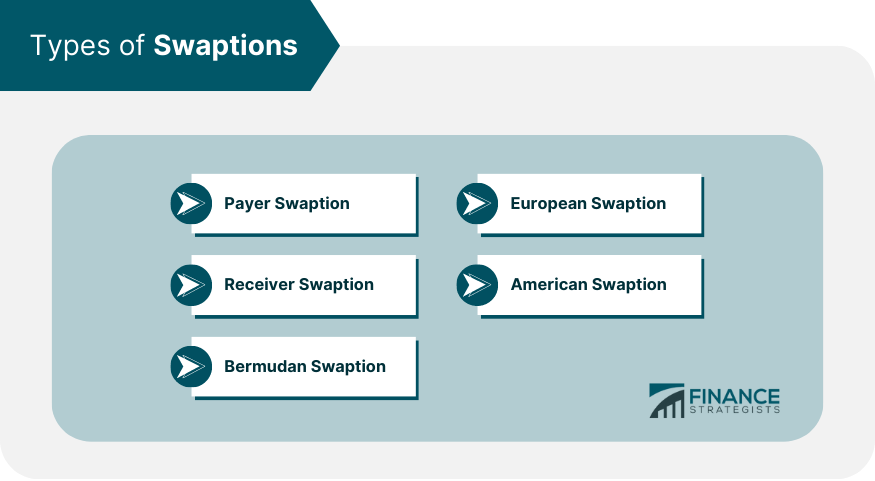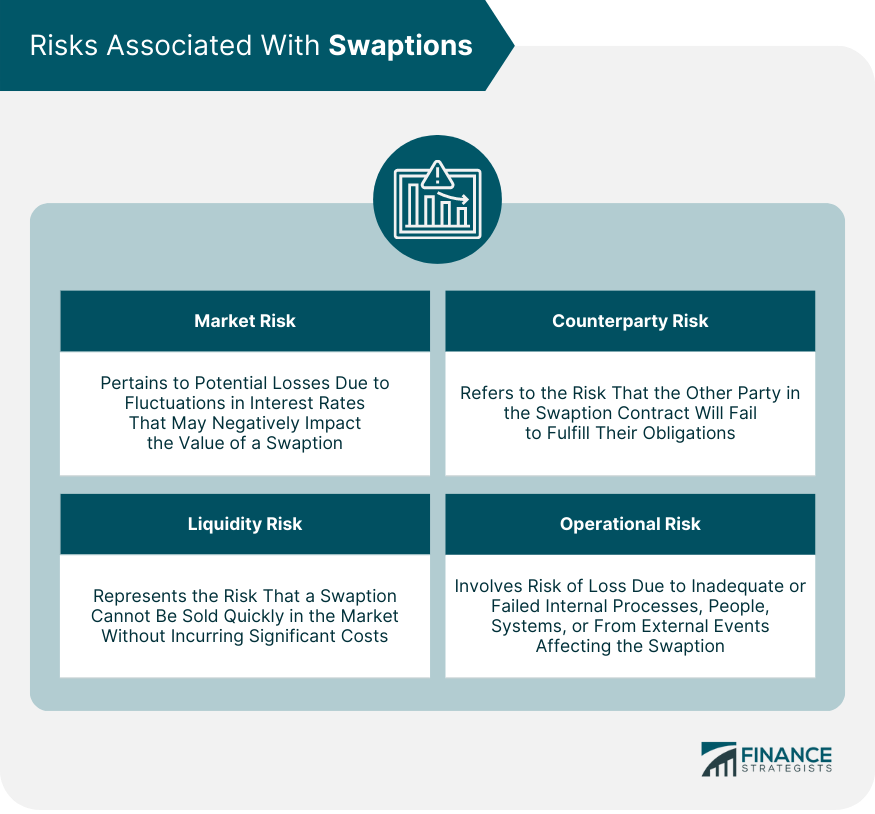Definition of Swaptions
A swaption, or swap option, is a financial instrument that provides an investor with the right, but not the obligation, to enter into an interest rate swap agreement at a specified future date.
Swaptions play a crucial role in the world of financial derivatives, allowing investors to manage interest rate risks and speculate on future interest rate movements.
There are several types of swaptions, including payer swaptions, receiver swaptions, Bermudan swaptions, European swaptions, and American swaptions.
Each type offers distinct rights and obligations concerning the exchange of fixed and floating interest rate payments.
Despite their utility in managing interest rate risk and speculating on future rate movements, swaptions come with various risks.
Market risk emerges from potential interest rate changes that could negatively impact the swaption's value. Counterparty risk exists if the other party defaults on their contractual obligations.
Liquidity risk arises if the swaption cannot be easily sold without significant cost, and operational risk results from internal or external process failures.
How Swaptions Work
A swaption grants the holder the right to enter into an interest rate swap, in which two parties agree to exchange a series of interest payments based on a notional principal amount.
The swaption's buyer can exercise the option at a predetermined exercise date, paying a premium to the seller for this right.
If the swaption holder chooses to exercise the option, the parties will exchange fixed and floating interest rate payments at predetermined intervals for the life of the swap agreement.
Types of Swaptions
Swaptions come in various types based on the nature of the option and the manner in which they can be exercised. Some common types include:

Payer Swaption: The buyer has the right to enter into a swap where they pay the fixed rate and receive the floating rate.
Receiver Swaption: The buyer has the right to enter into a swap where they pay the floating rate and receive the fixed rate.
Bermudan Swaption: This swaption can be exercised on multiple specified dates within a predetermined time frame.
European Swaption: This swaption can only be exercised on a single predetermined date.
American Swaption: This swaption can be exercised at any time during a predetermined time frame.
Uses of Swaptions
Swaptions are used for various purposes in financial markets, including:
Hedging interest rate risk by locking in fixed or floating interest rates
Speculating on future interest rate movements to generate profits
Managing the duration of fixed income portfolios
Customizing the interest rate exposure of an investment portfolio
Pricing a Swaption
Factors Influencing Swaption Pricing
The pricing of a swaption is influenced by several factors, such as:
The time to expiration of the swaption
The current interest rates and their expected future path
The volatility of the underlying interest rates
The credit quality of the counterparties involved
The notional principal amount of the swap
Risks Associated With Swaptions

Market Risk
Market risk arises from the possibility that interest rate movements will negatively affect the value of a swaption before it can be exercised or sold. Swaptions are particularly sensitive to changes in interest rates and their volatility.
Counterparty Risk
Counterparty risk is the risk that the other party involved in the swaption will fail to meet their obligations. This risk is higher if the swaption is traded over-the-counter (OTC), where there is no centralized exchange to ensure the performance of contracts.
Liquidity Risk
Liquidity risk is the risk that a swaption holder may not be able to sell the swaption in the market without incurring a significant cost. This risk can be high in periods of market stress when liquidity tends to dry up.
Operational Risk
Operational risk is the risk of loss resulting from inadequate or failed internal processes, people, and systems, or from external events. In the context of swaptions, it could arise from errors in the execution, settlement, or documentation of swaption contracts.
Swaptions and Interest Rate Swaps
Understanding Interest Rate Swaps
Interest rate swaps are derivative contracts where two parties agree to exchange interest payments based on a notional principal amount. Typically, one party agrees to pay a fixed interest rate, while the other pays a floating rate, often based on a benchmark like LIBOR.
Interest rate swaps are commonly used to hedge against interest rate risk, or to speculate on future interest rate movements.
Understanding interest rate swaps is crucial for comprehending the nature and function of swaptions, which are essentially options on these swap agreements.
Role of Swaptions in Interest Rate Swaps
Swaptions provide flexibility and risk management in the realm of interest rate swaps. For instance, a company expecting to issue debt in the future could use a payer swaption to hedge against the risk of rising interest rates.
If interest rates rise before the debt is issued, the company can exercise the swaption and enter into a swap agreement to pay a fixed rate and receive a floating rate, effectively locking in the current lower interest rate.
Risk Management Using Swaptions in Interest Rate Swaps
Swaptions can provide effective risk management for interest rate swaps. A holder of a receiver swaption, for instance, benefits if interest rates fall.
This could offset losses in a swap agreement where the holder is paying a fixed rate and receiving a floating rate. Thus, swaptions can serve as a form of insurance against adverse interest rate movements in swap agreements.
Swaption Strategies
Swaption Hedging
Swaption hedging is a strategy used to protect against adverse movements in interest rates. For instance, a company expecting to receive fixed payments and pay floating payments in a future swap agreement could buy a payer swaption to hedge against the risk of falling interest rates.
Swaption Straddles
A swaption straddle involves buying a payer swaption and a receiver swaption with the same strike price and expiration date. This strategy is used when there is an expectation of large movements in interest rates, but the direction of the movement is uncertain.
Swaption Collars
A swaption collar involves buying a payer swaption at one strike price and selling a receiver swaption at a different strike price. This strategy provides a level of protection against rising interest rates, while also limiting potential gains if interest rates fall.
Swaption Strategies for Portfolio Management
Portfolio managers use swaptions to adjust the interest rate risk profile of their portfolios. For instance, if a portfolio manager anticipates a rise in interest rates, they might buy payer swaptions to increase the portfolio's sensitivity to rising rates.
Conversely, if they anticipate a drop in rates, they might buy receiver swaptions to benefit from falling rates.
Regulatory Environment for Swaptions
Role of Regulatory Bodies in Swaption Market
Regulatory bodies play a critical role in overseeing the swaption market, setting rules and standards to ensure fair and transparent trading, and protecting market participants from fraud and manipulation.
In the United States, the Commodity Futures Trading Commission (CFTC) and the Securities and Exchange Commission (SEC) are the primary regulators of the derivatives market, including swaptions.
Basel III Implications for Swaptions
Basel III is a set of international banking regulations that aim to improve the banking sector's ability to absorb shocks from financial and economic stress.
For swaptions, Basel III requires banks to hold more capital against potential losses from their derivatives trades, including swaptions. This has increased the cost of trading swaptions and affected their liquidity.
Dodd-Frank Wall Street Reform and Consumer Protection Act's Impact on Swaptions
The Dodd-Frank Act, enacted following the 2008 financial crisis, has had significant implications for the swaption market.
The Act has introduced central clearing requirements for many derivatives, including certain types of swaptions. This has reduced counterparty risk but has also increased the costs of trading due to clearing fees and margin requirements.
Recent Trends in Swaption Market
Technological Advancements and Their Influence on Swaption Trading
Technological advancements have revolutionized the swaption market. The rise of electronic trading platforms has increased market transparency, reduced trading costs, and made the market more accessible to a broader range of participants.
Algorithmic trading and high-frequency trading have also become more prevalent, leading to increased trading volumes and tighter bid-ask spreads.
Forecasted Developments in the Swaption Market
Looking ahead, several developments could shape the future of the swaption market.
The transition away from LIBOR to alternative reference rates will have significant implications for swaption pricing and contract specifications. Also, the continued evolution of financial technology could further transform the way swaptions are traded and managed.
Conclusion
In essence, a swaption, or swap option, is a robust financial instrument granting the holder the right, but not the obligation, to enter into an interest rate swap agreement at a future date.
Swaptions come in various types, including payer, receiver, Bermudan, European, and American, each offering distinct advantages based on the investor's needs.
Despite their utility in hedging and speculation, swaptions carry various risks. Market risk, counterparty risk, liquidity risk, and operational risk are all inherent in swaption trading, underscoring the need for investors to thoroughly understand these complexities before engaging in swaption contracts.
The dynamic nature of swaptions and the risks associated present challenges for investors, but also offer exciting opportunities for those adept at navigating the financial markets.
As with any investment, due diligence and risk management are key to successful participation in the swaption market.
Swaption (Swap Option) FAQs
A swaption, short for swap option, is a financial derivative that grants the holder the right, but not the obligation, to enter into a specific interest rate swap agreement at a future date.
There are various types of swaptions, including payer swaptions, receiver swaptions, Bermudan swaptions, European swaptions, and American swaptions. Each type has unique characteristics and can be exercised at different times.
Swaption pricing depends on several factors, including the time to expiration, current and expected future interest rates, volatility of the underlying interest rates, credit quality of the counterparties, and the notional principal amount of the swap.
Key risks associated with a swaption include market risk, counterparty risk, liquidity risk, and operational risk. These risks can impact the value of the swaption and the ability of parties to meet their contractual obligations.
Regulations like Basel III and the Dodd-Frank Act have significantly impacted the swaption market. These regulations have introduced higher capital requirements and central clearing requirements for certain types of swaptions, affecting their liquidity and trading costs.
True Tamplin is a published author, public speaker, CEO of UpDigital, and founder of Finance Strategists.
True is a Certified Educator in Personal Finance (CEPF®), author of The Handy Financial Ratios Guide, a member of the Society for Advancing Business Editing and Writing, contributes to his financial education site, Finance Strategists, and has spoken to various financial communities such as the CFA Institute, as well as university students like his Alma mater, Biola University, where he received a bachelor of science in business and data analytics.
To learn more about True, visit his personal website or view his author profiles on Amazon, Nasdaq and Forbes.











